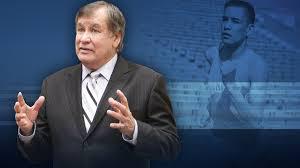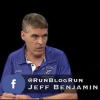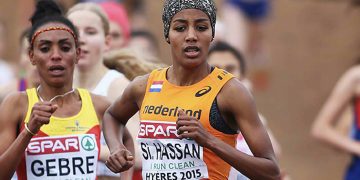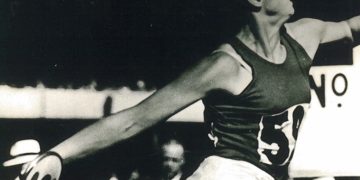Jeff Benjamin caught up with 1964 Olympic champion Billy Mills, who has joined many concerned Americans over the new pipeline that passes through Lakota lands. Billy Mills is part Lakota and is concerned about his people’s historic lands.
 Billy Mills, photo courtesy of NCAA.org
Billy Mills, photo courtesy of NCAA.org
Update October 16. Billy Mills asked Jeff Benjamin to provide some clarification on key matters with the story. We have provided that and are republishing.
Updated October 16, with updates from Billy Mills
Don’t ever tell Billy Mills that nothing is impossible.
Billy Mills is fighting against the powerful Energy Transfer Company’s plan to build an 1100 mile long oil pipeline through native Lakota Indian lands to Illinois. Alongside thousands of fellow protesters of all different backgrounds, Mills is showing the same passion and energy which he displayed in grand style more than 50 years ago. In the 1964 Tokyo Olympics, shocking everybody by not only taking on the world’s best runners in the 10,000 meters, but defeating them in winning the gold medal, Billy Mills stunned the world.
The 78 year old half-Lakota/half white athlete also possesses a unique perspective in this current fight over not only land and profit, but also over prejudice and discrimination as well. As a young person, his mixed blood background led to him feeling ostracized. “The full Lakota rejected me,” Mills said recently. “If we were accepted into white society, you would have to totally reject the Lakota ways…I felt I was locked out of the American Dream.”
Mills’ early life was also filled with personal tragedy as well, notably the death of his mother when he was only a child. But it was from that tragedy that he was given a goal and belief to try and excel. “My Dad spoke with me when my Mom died,” he said. “We were fishing and he told me that I had broken wings, which meant my soul was broken. My dad then told me that it takes a dream to fix broken souls.”
It was from this conversation that Mills was able to try and better himself, despite also losing his father at a young age as well. “You take the culture, tradition and spirituality and it gives you the virtues and values of society which then gives you confidence!” Mills also took to Christianity, instilling himself with many of the positive tenets of the religion.
“I took my Lakota Tribal culture, traditions, and spirituality, then extracted out the virtiues and values that empowere my culture, traditions and spirituality and places those virtues and values into my educational pursuit and my Olympic pursuit.” added Billy Mills.
“Why? Because it is the virtues and values of my culture, tradition, and spirituality that gave me confidence, direction, and clarity of mind to make positive decisions and stay the course. This empowered me and my running.” noted Billy Mills.
Billy Mills found the virtues and values of his culture empowered his running and his focus. Mills mental strength and his culture made his running stronger.
Not that it wasn’t without challenges. While finding that he was quite good at running (he went on to compete in full scholarship at Kansas), Mills still faced discrimination from both ends. “I was one of the first of the bottom of my tribe to go out, compete and get an education, and I took Lakota culture with me as well,” he said. “But I also found constant conflict with white society.”
This attitude, along with Mills’ uncanny ability to use the concept of visualization (something not really done in that era) launched Mills onto the 1964 American Olympic team in the 10,000. But once again Mills started at the bottom. No one expected to be in the top group of finishers. Mills’ 10K PR was almost a minute behind the world’s best in the event. Among his competitors would be fellow American Gerry Lindgren, Mohammed Gammoudi of Tunisia, Mamo Wolde of Ethiopia and the heavy favorite, multiple world record holder Ron Clarke of Australia.
Yet at halfway, there was Mills battling it out with the worlds’ best. “My split time at 5000 meters was a personal best time for me,” said Mills in a 1996 interview. “I just kept on visualizing I would be exactly where I was and it was working.”
On the final lap, and despite some elbows and body contact, Mills launched into a furious sprint off of the final turn. Mills passed Clarke and Gammoudi to pull off what Runners World magazine has called, “The Greatest Track Upset in Olympic History”. Mills won the gold medal before a stunned and euphoric crowd. All the more amazing was that Mills’ time of 28:24.4 was a minute faster than his best time and an Olympic record. Mills became the third Native-American to win Olympic Gold in history (Jim Thorpe and Duke Kahanamoku in 1912) and then would run the Olympic Marathon a few days later, finishing 14th behind Abebe Bikila. One year later, Mills would tie with Lindgren at the AAU National Championships to set the world record for 6 miles, clocking 27:11.6. (Actually, Billy Mills’ time in modern timing era would have been 27:11.55).
While his victory galvanized American track fans, Mills found more doors open to him, albeit with some negatives attached. “I still had a feeling like I didn’t quite belong, based on the attitudes of people,” said Mills. People would invite the Olympic Champion to parties with the mantra of, “Come on to the party, you’re one of us now.”
But Mills refused to let these attitudes destroy him. As stated previously, he looked towards his inward positive passion for life to drive him forward. “The running definitely healed me because it did lead to acceptance and it was from that I was able from a spiritual standpoint to find a piece of mind.”
In his post-Olympic years he became a successful business and family man. His group “Running Strong for American Indian Youth” has affected the lives of thousand of Native-American youth who have faced similar challenges like Mills in American Society. The 1984 movie “Running Brave”, where Robby Benson portrays Mills inspiringly in all his tragedies and triumphs, is still required watching for track athletes and fans to this day. Mills is also involved in raising funds to fight diabetes, a condition he actually has, even going back to his Olympic days.
Yet, while firm in his convictions, Mills still to this day is all-inclusive and still believes in the optimistic approach to life. “It’s still hard for a Native-American to join the American Dream,” he said. But like any challenge, Mills hopes his example can help those find their passion, and not only in the Native-American community.
Mills recounted how he met a man from Maldives who explained to him how his father had died when he was young and it was the “Running Brave” film which saved him. “He told me he watched it many times and wanted to be like me,” said Mills humbly. “He went on to become his country’s first ever Olympic Flag Bearer in the 1988 Seoul Games, and also represented his country again in 1992 in Barcelona.” Today Doctor Hussain Haleem, like the idol he has emulated, also speaks to youth and runs a sports camp in his country. Mills is rightly quite proud of the effect he has had on people in all walks of life. “In my Journey in Sport, it is the journey and not the destination that empowers us!,” he exclaimed.
As for his fight against a seemingly insurmountable force, Mills will still carry with him those same forces which launched him to the Gold Medal podium in Tokyo. “Find the passion,” Mills said. “Develop it and Boom! Magic happens and it can turn into a miracle!”
PS- As of this writing the pipeline company fight still continues. Yet, while last month a federal judge ruled the pipeline to go ahead, the Obama administration subsequently put a stoppage on it. “Construction of the pipeline on Army Corps land bordering or under Lake Oahe will not go forward at this time,” said a joint statement from the Department of Justice, the Department of the Interior, and the U.S. Army. “We request that the pipeline company voluntarily pause all construction activity within 20 miles east or west of Lake Oahe.”
Stay tuned.
Author

Jeff Benjamin has written for 30 years for American Track and Field along with RunBlogRun. The Former President of the Staten Island AC & Chair of the Staten Island Running Association was the 5th man scorer for his Susan Wagner High School NYC XC City Championship team. Also a member of the College of Staten Island Sports Hall of Fame for XC, Jeff currently serves as the LDR Chairman for USATF NY. A passionate (or fanatical) follower of the Sport, some of Jeff's subjects have included Sebastian Coe, Emma Coburn, Eamonn Coghlan, Matt Centrowitz, Jim Spivey, Galen Rupp, Joe Newton, Tom Fleming, Ajee’ Wilson, Bill Rodgers, Allan Webb, Abel Kiviat, Jordan Hassay, Marty Liquori, Caster Semenya, Rod Dixon, Carl Lewis and Jim Ryun as well as Book Reviews and articles covering meets and races in the Northeast U.S.
View all posts




















